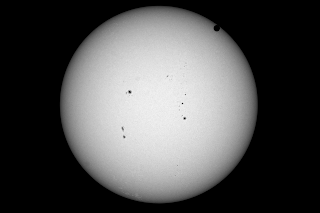Venus Transit Images
As documented in my Expedition Notes, I was on the summit of Haleakala for the 2012 Transit of Venus. Here are a couple of representative images. First, the beginning of the transit, in white light - a stack of 10 images taken with a Canon EOS 40D and aligned and processed in Photoshop. Click on the image to see it full-size:
This is the color of light the Sun puts out. It is not yellow or orange - people only think it is because the only time you can actually stand to see the Sun is when it is rising or setting, especially through clouds (and it is still not safe to look at it this way!). At those times, the light is significantly reddened from the passage through very thick layers of air and dust. Note the sunspots and other details - white light is interesting. But what is *very* interesting is Hydrogen Alpha light. This image of the end of the Transit is a stack of 7 images taken with a Sony NEX 5N camera and aligned and processed in Photoshop. Again, click on the image to see it full-size:
Hydrogen Alpha is a specific wavelength of red light emitted by Hydrogen when one of its electrons makes a specific quantum transition. It is used because it shows very different details than white light. Notice again the sunspots - they are not quite as visible. However, much more surface detail is visible on the disk of the Sun. In addition - notice the (heavily-processed!) red flames around the disk of the sun. These are real - they are called "prominences". The exposures I was taking were not optimized for prominences, so there is not much detail there - but you can see them! I chose an orange color for this image because, to my eye, I can see more details than I can with a pure red image.
Finally, I assembled an animation of 75 images from both scopes, side-by-side. The left (red) image is the Hydrogen Alpha image and the right is the white light. Apologies for the shakiness - I'm still on vacation and my laptop is the only tool I have available. Perhaps some day I'll make a much nicer, smoother video:
This is the color of light the Sun puts out. It is not yellow or orange - people only think it is because the only time you can actually stand to see the Sun is when it is rising or setting, especially through clouds (and it is still not safe to look at it this way!). At those times, the light is significantly reddened from the passage through very thick layers of air and dust. Note the sunspots and other details - white light is interesting. But what is *very* interesting is Hydrogen Alpha light. This image of the end of the Transit is a stack of 7 images taken with a Sony NEX 5N camera and aligned and processed in Photoshop. Again, click on the image to see it full-size:
Hydrogen Alpha is a specific wavelength of red light emitted by Hydrogen when one of its electrons makes a specific quantum transition. It is used because it shows very different details than white light. Notice again the sunspots - they are not quite as visible. However, much more surface detail is visible on the disk of the Sun. In addition - notice the (heavily-processed!) red flames around the disk of the sun. These are real - they are called "prominences". The exposures I was taking were not optimized for prominences, so there is not much detail there - but you can see them! I chose an orange color for this image because, to my eye, I can see more details than I can with a pure red image.
Finally, I assembled an animation of 75 images from both scopes, side-by-side. The left (red) image is the Hydrogen Alpha image and the right is the white light. Apologies for the shakiness - I'm still on vacation and my laptop is the only tool I have available. Perhaps some day I'll make a much nicer, smoother video:
And that's about it for now. Stay tuned, I may play with this data some more in the coming weeks...
June 25, 2012 edit: Edward Plumer, my brother-in-law, has posted his observations on his blog.



Comments